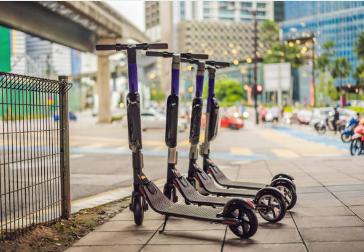
Electric Kick Scooters: Redefining Urban Mobility
Electric kick scooters have exploded in popularity in recent years as a fast, affordable, and environmentally friendly mode of urban transportation. Major cities worldwide have seen a flood of app-rentable e-scooters from various companies.
However, their success will depend on how well cities integrate them with existing transit networks to benefit all residents. With thoughtful infrastructure updates and regulations, electric kick scooters can fulfill their potential as a sustainable transportation option.
Continue reading to learn the factors driving their growth and their benefits.

The Rise of Electric Kick Scooters
While kick scooters have been around for over a century, the recent electric kick scooter phenomenon has its roots in tech startup culture. Various companies spotted a market gap. That gap led them to introduce dockless electric scooters that could be accessed through mobile apps and rented by the minute.
In September 2017, Santa Monica, California, became the first city with app-rentable e-scooters deployed in large numbers. Usage quickly took off, indicating strong consumer demand.
Other companies rushed to get their own fleets on the streets of major metros like Los Angeles, San Francisco, and New York City. It soon became common to see e-scooters zipping through urban landscapes and piled on sidewalks when not in use.
The resultant effect of this boom is that the global e-scooter revenue is projected to reach $ 34.48 billion in 2024 alone as adoption spreads.
Factors Driving the Growth of the Electric Kick Scooter Market
Several key factors are fueling the soaring popularity and adoption of electric kick scooters globally:
1. Rising Urbanization and Traffic Congestion
The world is urbanizing at an unprecedented pace. According to the United Nations, over 55% of the global population now lives in cities. This proportion is expected to grow to 68% by 2050.
Mass urban migration leads to crowded metro areas and increased traffic congestion.
Electric scooters provide quick, inexpensive, short-range personal transportation that connects to public transportation hubs. They help commuters avoid traffic congestion and lengthy train or bus rides by providing convenient pick-up and drop-off at any location.
2. Focus on Micro-mobility Solutions
Municipal governments plagued by congestion are actively re-evaluating transportation and embracing creative micro-mobility solutions. Electric scooters, bikes, and other small electric vehicles allow efficient short-range travel using minimal street space compared to cars.
Micromobility solutions fill the gap between walking or biking and mass transit over short point-to-point routes. Integrating them creates a diverse, resilient transportation network.
3. Environmental Sustainability
With the urgent threat of climate change, cities worldwide are trying to reduce carbon emissions.
Shifting commuters out of cars onto electric scooters and bikes significantly cuts emissions, especially over short trips. E-scooters have a relatively small manufacturing and operational carbon footprint compared to internal combustion engine vehicles. They support broader environmental goals when paired with renewable electric grids.

4. Shared Mobility Business Models
Dockless e-scooter sharing services like Bird and Lime have accelerated adoption. These platforms allow riders to access scooters on-demand through mobile apps. Usage is billed by the minute rather than requiring ownership.
Shared mobility makes e-scooters accessible and affordable to wider demographic.
5. Advances in Electric Propulsion
Plummeting costs, improved performance, and an extended range of lithium-ion batteries have enabled transportation innovations.
Many e-scooters today can travel longer miles on a single charge, easily covering most urban commutes. While early e-scooters had kinks, rapid improvements in underlying electric propulsion tech have created a much more usable transportation option attractive to the masses.
6. Changing Urban Demographics
E-scooters resonate strongly with younger urbanites. They appreciate the flexibility, cost savings, and tech-enabled convenience of shared e-scooters.
7. Greater Adoption of On-Demand Services
Shared e-scooters capitalize on the broader rise of the on-demand economy. Urban dwellers increasingly expect real-time access to mobility, food, entertainment, and other services at their fingertips. The ubiquity of smartphones enables accessing e-scooters spontaneously as needed.

Benefits of Electric Scooters
Here are some of the potential benefits of electric kick scooters as an urban transportation option:
- Reduced car traffic and emissions: E-scooters provide a convenient alternative to short urban car trips. Fewer car trips mean less congestion and pollution.
- Affordability: The rental model of shared e-scooters makes them highly affordable compared to other transportation options. E-scooter rental rates typically cost $1 plus 15-35 cents per minute of riding time. This is far cheaper than hailing a taxi or rideshare for short city trips.
- Flexibility: The dockless nature of most shared e-scooters allows riders to pick up and park them anywhere within a permitted service area. There is no need to walk to and from fixed docking stations.
- Intermodal connectivity: With ample access and parking around the city, e-scooters can provide critical links connecting public transit modes into an integrated network. They serve as efficient on-demand feeders to bridge gaps between commuters’ origins/destinations and transit hubs.
- Fun factor: Zipping on an e-scooter can be more exciting and enjoyable than other transit options. They invite exploration of the urban landscape.
- Mobility for all: E-scooters can help bridge transportation gaps for communities underserved by existing transit. Their flexibility makes them accessible in many areas.

Final Thoughts
The sudden rise of electric kick scooters demonstrates the appetite for affordable, convenient, and sustainable mobility.
With careful planning and ongoing innovation, e-scooters and other emerging microtransit alternatives represent an exciting path to more livable cities worldwide. The urban mobility revolution is already underway.
Need Accountancy Support?
For information on bespoke training, or if you have any other questions for Makesworth Accountant, please fill in your details below
















 151
151